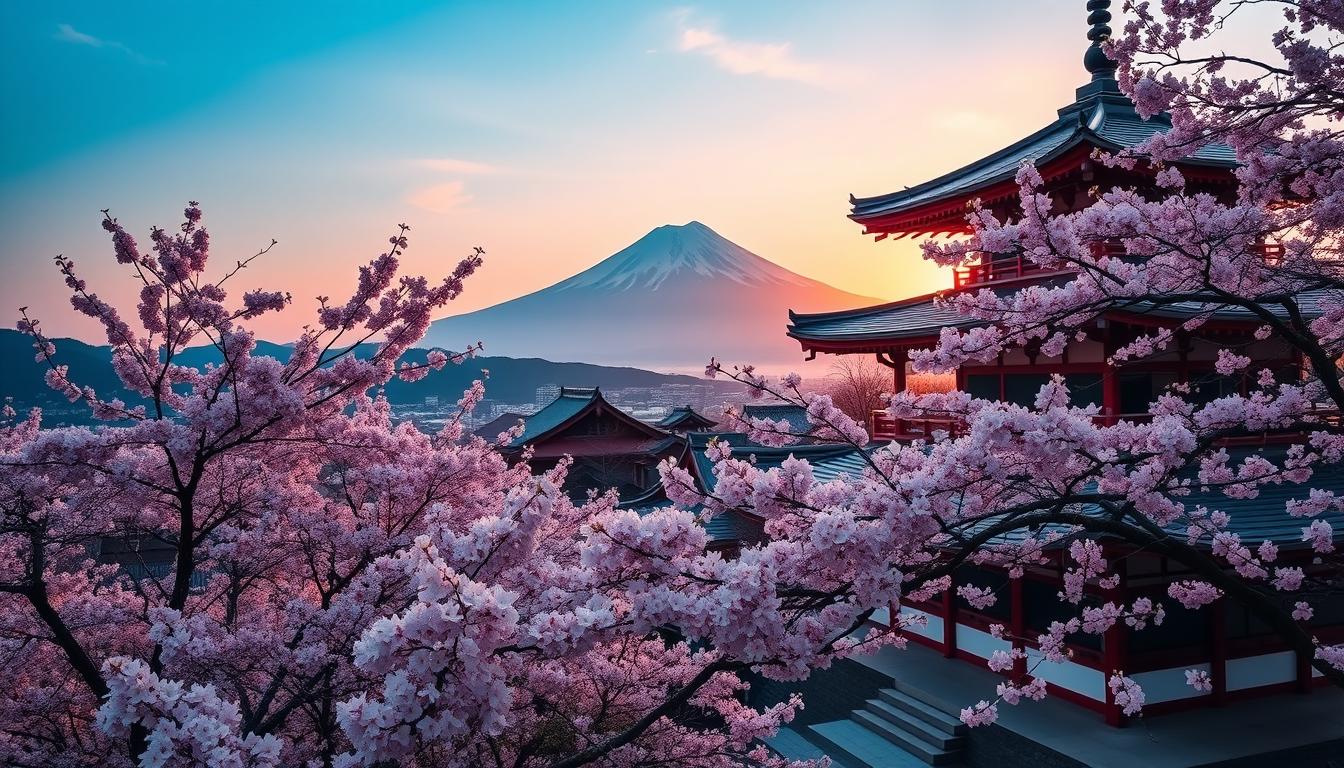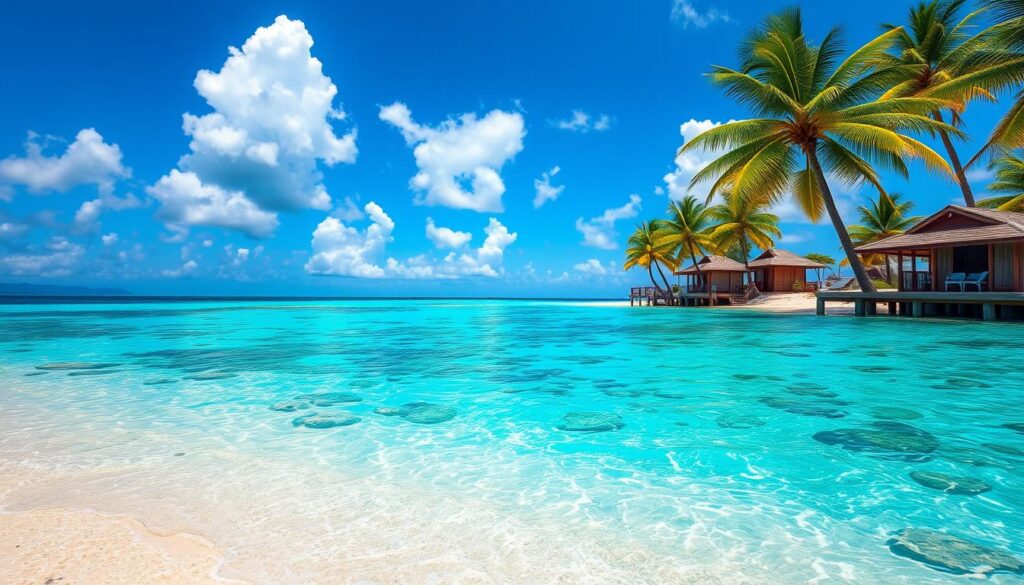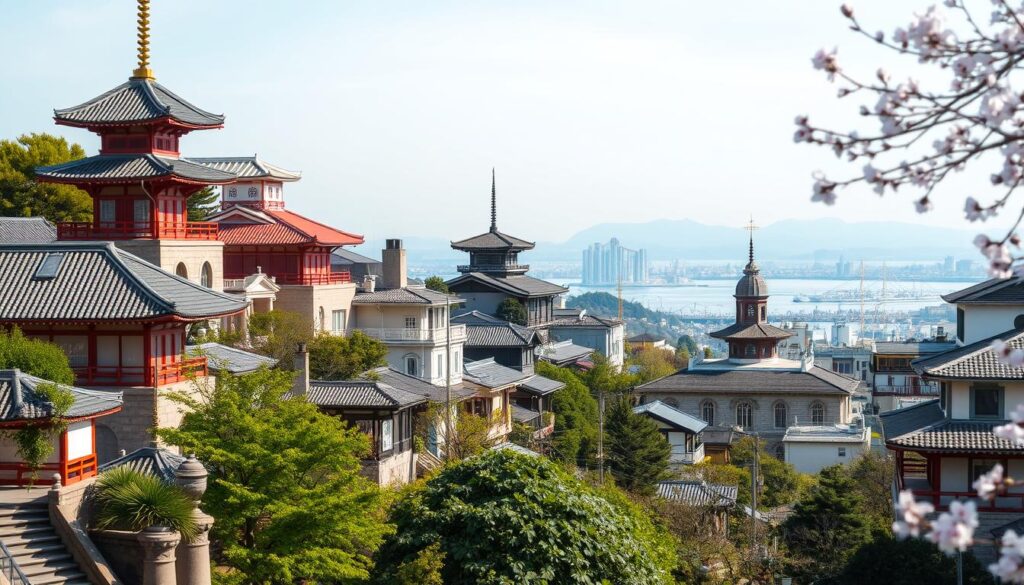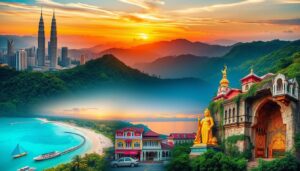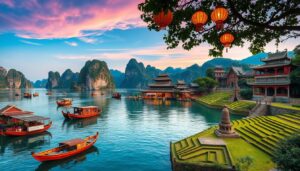I’m excited to share with you the amazing places in Japan. From Tokyo’s high-tech towers to Kyoto’s quiet bamboo forests, Japan is a mix of old and new. It’s famous for its food, friendly people, and easy-to-use public transport.
Japan is home to stunning sights like Hokkaido’s lavender fields and Okinawa’s clear beaches. You can also see Mount Fuji. There are art museums, old temples, cherry blossoms, and autumn colors to explore. Japan has something for everyone, whether you love city life or nature.
Key Takeaways
- Japan is a diverse destination with a harmonious blend of modern and traditional attractions.
- The country is renowned for its incredible cuisine, hospitable people, and efficient transportation system.
- Japan’s natural beauty spans from the lavender fields of Hokkaido to the beaches of Okinawa.
- Visitors can explore contemporary art museums, historic temples, cherry blossoms, and autumn foliage.
- Japan offers a wide range of experiences, from thrilling urban adventures to peaceful natural retreats.
1. Tokyo: The Vibrant Heart of Japan
Tokyo is a mix of the latest trends and old traditions. It’s a city full of life, from the bright streets of Shibuya and Shinjuku to the rich history of Asakusa. Whether you love new tech, lively youth culture, or ancient customs, Tokyo has something for everyone.
Exploring Shibuya and Shinjuku
Seeing Shibuya Crossing is a must. It’s the busiest spot for people walking. After that, explore Shibuya’s cool shops, food, and fun places. Then, head to Shinjuku to see Memory Lane and the Shibuya Sky for amazing views.
Must-See Attractions in Akihabara
Akihabara, or “Electric Town,” is a dream for tech and anime lovers. It’s full of arcades, unique shops, and themed cafes. Experience the bright streets and geeky fun in this special place.
Cultural Experiences in Asakusa
Asakusa is a step back in time. Visit Sensoji Temple, Tokyo’s oldest temple. Walk Nakamise Street for a taste of old Japan. Don’t miss the Meiji Shrine, a peaceful spot in the city.
“Tokyo is a city of contrasts, where the ancient and modern coexist in a captivating harmony.” – Michelin Guide
2. Kyoto: A Journey Through History
Kyoto, Japan’s former imperial capital, is a true gem of traditional Japan. It’s filled with cultural sights, from famous temples to peaceful tea houses and the magical Geisha districts. Exploring Kyoto lets you dive deep into Japan’s rich heritage.
Iconic Temples: Kinkaku-ji and Fushimi Inari
Visiting Kyoto isn’t complete without seeing the Kinkaku-ji, or Golden Pavilion. This Zen temple is a marvel, with its golden exterior mirrored in a calm pond. Don’t miss the Fushimi Inari Shrine, known for its bright red torii gates that climb up a mountain, offering a stunning view.
Traditional Tea Houses and Geisha Districts
Kyoto is famous for its traditional tea houses and Geisha districts. You can experience Japanese tea ceremonies, where Geisha elegance is unforgettable. Walking through Gion, you might see Geisha on their way to events.
Best Time to Visit for Cherry Blossoms
Kyoto shines in late March to early April, when cherry blossoms bloom. Parks and gardens are filled with pink flowers, creating a stunning view. This is the perfect time for hanami, enjoying the beauty of cherry blossoms.
“Kyoto is a living museum, a timeless city that seamlessly blends the past and present, offering travelers a unique and unforgettable experience.” – Lonely Planet
Kyoto offers something for everyone, from iconic temples to the beauty of cherry blossoms. It’s a place that will capture your heart and leave a lasting memory of traditional Japan and its Kyoto cultural attractions.
3. Osaka: The Culinary Capital
Osaka is known as Japan’s culinary capital. It’s famous for its Osaka food scene and love for Japanese street food. The city’s food scene is vibrant, with everything from Dotonbori’s bustling streets to hidden spots in urban Japan.
Famous Street Food: Dotonbori Delights
Dotonbori is a must-see for food lovers. It’s filled with street stalls and eateries. You can try takoyaki and okonomiyaki, local favorites. The neon lights and smells of food make it a unique experience.
Historic Sites: Osaka Castle
Osaka is not just about food. It also has a rich history. Osaka Castle is a key attraction, showing Japan’s past. The castle’s beauty is a nice contrast to the city’s lively food scene.
Exciting Attractions: Universal Studios Japan
Osaka also has top attractions like Universal Studios Japan. It’s a theme park with rides, shows, and experiences for all ages. From Harry Potter to Jurassic World, it’s a day of fun and excitement.
| Osaka Food Specialty | Description |
|---|---|
| Takoyaki | Fried octopus balls, a beloved street food in Osaka |
| Okonomiyaki | Savory Japanese pancakes, often referred to as “Osaka’s soul food” |
| Kushikatsu | Battered and deep-fried skewered meat and vegetables, a specialty in the Shinsekai district |
4. Hiroshima: A City of Peace
Hiroshima has changed from a city of tragedy to a symbol of peace and strength. The Hiroshima Peace Memorial Park and its museum offer a deep and moving experience. They show the city’s history and its dedication to world peace.
The Hiroshima Peace Memorial Park
The Hiroshima Peace Memorial Park is at the heart of the city’s change. It’s a quiet place to remember the victims of the atomic bombing in 1945. The park has the Atomic Bomb Dome, the Children’s Peace Monument, and the Cenotaph for A-bomb Victims. These remind us of the tragedy.
Learning About History at the Museum
The Hiroshima Peace Memorial Museum is a key place to learn about the city’s past. It attracts over 1 million visitors each year. The museum tells the story of the bombing and its effects. It also shares the stories of survivors and efforts for peace.
Day Trip to Miyajima Island
Miyajima Island is a great day trip from Hiroshima. It’s famous for its floating torii gate and rich culture. Visitors can see the historic Itsukushima Shrine and climb Mount Misen for beautiful views.
The island is also a place to learn about Japanese traditions. You can watch traditional tea ceremonies and meet friendly deer.
“Hiroshima has become a symbol of peace, a city that has overcome a tragic past to become a beacon of hope for a world without nuclear weapons.”
Hiroshima’s journey from devastation to peace shows the power of the human spirit. By visiting the park, museum, and Miyajima Island, travelers can understand Japanese history. They also see the importance of peace and reconciliation worldwide.
5. Hokkaido: Nature’s Wonderland
Hokkaido, Japan’s northernmost main island, is a paradise for nature lovers. It offers top-notch ski resorts, stunning landscapes, and unique cultural experiences. These make it a must-see place.
Ski Resorts and Winter Sports
Hokkaido is famous for its ski resorts, especially Niseko. It gets some of Japan’s best snow from January to February. Niseko is perfect for winter sports fans.
There’s more than skiing here. You can try snowmobiling, snowshoeing, ice fishing, and relaxing in hot springs.
Exploring Sapporo and Its Beer Museum
Sapporo, Hokkaido’s largest city, is full of culture and food. It hosts the Sapporo Snow Festival, drawing over 2 million visitors. The city’s Odori Park features amazing snow and ice sculptures.
Sapporo is also known for its great beer. The Sapporo Beer Museum lets you learn about its history and brewing.
Summer Flower Fields at Furano
Hokkaido is beautiful in summer too. Furano, a town in a lush valley, is famous for its lavender and flower fields. These bloom from June to August.
From the Furano Ropeway, you can see stunning views of the valley.
Hokkaido has more than ski resorts and flower fields. It has six national parks, like Shiretoko and Daisetsuzan. These parks let you explore untouched nature and see wildlife, like red-crowned cranes.
Hokkaido offers exciting winter adventures, cultural experiences, and natural beauty. It’s a memorable trip for anyone who visits.
6. Okinawa: Tropical Paradise
Okinawa is a hidden treasure in the East China Sea. It’s a tropical paradise with stunning beaches and clear waters. The Ryukyu culture here is unique, making it different from the rest of Japan.
Beautiful Beaches and Scuba Diving
Okinawa has some of Japan’s most beautiful beaches. The sand is white, and the water is turquoise. It’s a great place to visit all year, but April, May, and September are the best months.
Summer in Okinawa, from June to October, is not ideal for beach trips. The weather is rainy and typhoons are common.
Okinawa is also a paradise for scuba diving. It has some of Asia’s best diving spots. But, Japan has strict diving rules. Without a license, you can only snorkel.
Unique Ryukyu Culture and Traditions
Okinawa’s culture is rich and unique. It’s influenced by Japan and China. You can see this in its architecture, food, and traditional arts.
Exploring Shuri Castle is a great way to learn about Okinawa’s history. It’s a UNESCO World Heritage site and was once the Ryukyu rulers’ seat.
Visiting Shurijo Castle
Shurijo Castle is a must-see in Okinawa. It was the heart of the Ryukyu Kingdom. You can explore its buildings, see the architecture, and learn about its history.
The admission fee for adults is 400 JPY (about $3.57 USD). It’s a great value for travelers.
Okinawa offers beaches, culture, and underwater adventures. It’s a unique part of Japan that everyone should see.
7. Nara: The Ancient Capital
Nara is in the heart of Japan, offering a peek into its rich history and culture. It was Japan’s first permanent capital. The city is famous for its Nara deer park, where hundreds of deer roam freely. They are seen as sacred messengers of the gods in ancient Japan and Japanese Buddhism.
Discovering the Great Buddha at Todai-ji
The Todai-ji Temple in Nara is a highlight. It houses the world’s largest bronze Buddha statue, standing at 49.2 feet tall. The Daibutsu, or Great Buddha, is a sight to behold, attracting visitors from all over.
Nara Park and Its Friendly Deer
Walking through Nara Park is a joy. Visitors can enjoy the company of the park’s famous deer, roaming free for over 1,300 years. These gentle creatures are sacred in Nara. They are often fed special “shika senbei” crackers by visitors, making for a unique experience.
Exploring Historical Temples and Shrines
Nara is not just about the deer park. It’s also home to many historical temples and shrines. Places like Kasuga Taisha Shrine and Yoshiki-en Gardens showcase the city’s rich spiritual and architectural heritage. These cultural treasures are a must-see for anyone visiting Japan.
Visiting Nara is an unforgettable experience. You can marvel at the Todai-ji Temple, feed the friendly deer in Nara Park, or explore the city’s historic temples and shrines. Nara leaves a lasting impression on your journey through ancient Japan.
8. Mount Fuji: Japan’s Iconic Landmark
Mount Fuji stands tall over Japan, drawing visitors from everywhere. It’s Japan’s highest peak, reaching 3,776 meters. It’s a key spot for those wanting to see Japan’s beautiful views.
Climbing Mount Fuji: Tips and Preparation
Hiking Mount Fuji is an adventure you won’t forget. The climb is open from early July to mid-September. Around 300,000 people climb it each summer.
To climb safely, you need the right gear, stay hydrated, and be in good shape. Being prepared is key.
The Five Lakes Surrounding Fuji
The Fuji Five Lakes are beautiful lakes at Mount Fuji’s base. Lake Kawaguchiko is the most visited. It offers amazing views of the mountain.
There are many places to stay and see the mountain. The lakes are perfect for enjoying Mount Fuji’s beauty.
Best Viewing Spots for Pictures
There are many places to take great photos of Mount Fuji. The Chureito Pagoda and Tokyo Skytree’s decks are top spots. Enoshima Island also offers great views.
Whether you want a sunrise photo or a wide landscape, Mount Fuji has it all. It’s a photographer’s dream.
“Climbing Mount Fuji is a life-changing experience that offers unparalleled views of Japan’s stunning landscapes.”
9. Nagasaki: A Blend of Cultures
Nestled in Japan’s southern region, Nagasaki is a city with a rich history. It has a mix of international influences and was a key port for trade and commerce. As one of the few Japanese cities open to foreign trade, Nagasaki has become a unique and captivating place for travelers.
Historical Significance of Dejima
At the heart of Nagasaki’s history is Dejima, a former Dutch trading post. It was Japan’s only window for foreign trade during the Edo period. This man-made island, now a UNESCO World Heritage site, shows the city’s past as a center of international exchange and cultural fusion.
Visitors can explore the Dutch-style buildings and feel the vibrant atmosphere of the past. This small island was a big influence on Nagasaki’s history.
Exploring Glover Garden
Glover Garden is another must-see in Nagasaki. It showcases the city’s unique mix of Eastern and Western architecture. The gardens and Victorian-style mansions once belonged to wealthy foreign merchants, including Thomas Glover.
The views of the harbor from the garden’s hilltop are breathtaking. Glover Garden offers a glimpse into Nagasaki’s history and its cultural blend.
The Atomic Bomb Museum
A visit to Nagasaki wouldn’t be complete without the Atomic Bomb Museum. This museum tells the city’s tragic history as the second target of a nuclear attack during World War II. It’s a powerful and thought-provoking experience.
The museum honors the resilience of the Nagasaki people and reminds us of the devastating effects of war. It’s a somber but important stop in Nagasaki.
Nagasaki’s history, culture, and natural beauty make it a captivating destination in Japan. Whether you’re exploring landmarks, enjoying festivals, or taking in the coastal views, Nagasaki offers unique experiences. It leaves a lasting impression on travelers.
10. Kamakura: Coastal Charm and Temples
Kamakura is a beautiful town along Japan’s coast. It’s known for its ancient temples, hiking trails, and seaside charm. Just an hour from Tokyo by train, it offers a peek into traditional Japan. The Kamakura Buddha is its main attraction.
Visit the Great Buddha (Daibutsu)
The Kamakura Daibutsu is a huge bronze statue, 13.35 meters tall. It’s in the Kotoku-in Temple and dates back to the 13th century. It’s the second-largest Buddha in Japan. Visitors can see its size and craftsmanship and learn about its history.
Beautiful Hikes and Coastal Views
Kamakura has many scenic hiking trails. The Daibutsu Hiking Course is one of them. It goes through forests and along the coast, past temples and Yuigahama Beach. Hikers see the Pacific Ocean and Kamakura Valley, a natural fortress.
Traditional Japanese Tea Experience
Kamakura is also known for its cultural experiences. Visitors can try a traditional Japanese tea ceremony. Many temples and ryokans offer these experiences. Guests can enjoy matcha tea and sweets and learn about Japan’s tea culture.
Kamakura is close to Tokyo and has many Zen Buddhist temples and coastal views. It’s a great day trip for those wanting to see traditional Japan. You can see the Daibutsu, hike, or try a tea ceremony. Kamakura is a treasure that shows Japan’s coastal beauty and temple tourism.
“Kamakura was the political capital of Japan from 1185 to 1333 during the rule of the Kamakura shogunate.”
11. Kanazawa: The City of Culture
Kanazawa is a city in central Japan that mixes old culture with new art. It has Edo-period districts that show Japan’s history. This makes it a special place for visitors.
Kenrokuen Garden: A Stunning Landscape
Kenrokuen Garden is known as one of Japan’s top gardens. It covers over 11 hectares and changes with the seasons. You can walk through it and see old pine trees, ponds, and tea houses.
Exploring the Samurai and Geisha Districts
The Nagamachi Samurai District and Higashi Chaya Geisha District show Kanazawa’s past. Nagamachi has samurai homes that give a peek into their lives. Higashi Chaya has geisha tea houses and a classy feel.
Local Crafts and the 21st Century Museum
Kanazawa is famous for gold leaf making. You can see workshops and shops with these crafts. The 21st Century Museum of Contemporary Art shows new art with interesting exhibits.
Kanazawa is full of beauty, from Kenrokuen Garden to the Samurai and Geisha districts. It’s a place where old traditions meet new art. It’s a key spot for those interested in Kanazawa gardens, Japanese cultural city, and samurai history.
12. Yokohama: Modern Attractions and Harbor Views
Yokohama is Japan’s second-largest city, known for its modern sights and beautiful harbor views. It’s a great place for those looking for something different from the usual tourist spots.
Visiting the Cup Noodles Museum
The Cup Noodles Museum in Yokohama is a must-see. It tells the story of instant noodles, a big part of Japanese culture. You can spend about 1.5 hours here, learning and having fun.
Exploring Chinatown
Yokohama has Asia’s biggest Chinatown, a lively area to explore. Walking through its streets, you’ll see Chinese gates and try real Chinese food. Don’t miss the Kuan Ti Miao temple and the Masobyo temple for a deeper cultural experience.
Enjoying the Views from Landmark Tower
For amazing views of Yokohama, head to the Landmark Tower. Once Japan’s tallest building, it now offers stunning views of the city and Tokyo Bay. It’s the best spot to see Yokohama’s modern side and its beautiful harbor.

